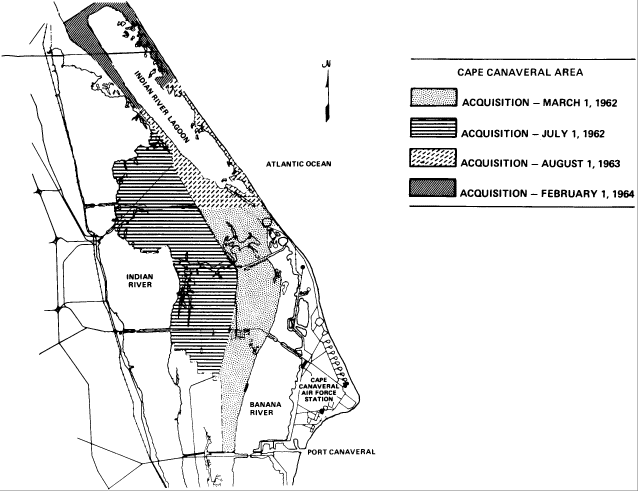
Merritt Island Purchase
On 1 September, NASA asked Congress to authorize the purchase of 324 square kilometers of land on Merritt Island, immediately north and west of the existing missile launching area at Cape Canaveral. In support of the proposal, Senator Robert Kerr of Oklahoma, Chairman of the Senate Committee on Aeronautical and Space Sciences, stressed several factors. Stringent time schedules for the lunar program made the area ideal. NASA could reduce costs by use of existing resources, facilities, and personnel. The tracking network stretched almost 14,500 kilometers into the Indian Ocean. If NASA tried to start from scratch in another area, this one aspect of the program would be prohibitive. NASA could plan efficiently for future expansion in the new complex. And lastly, Senator Kerr insisted that this facility would be used for many years to come. Congress was favorable.38

Land acquisition, 1962 - 1964.
On 21 September, Seamans requested the Army Corps of Engineers to undertake the land acquisition.39 Congress adjourned before authorizing the purchase. Without such authorization, NASA could not ask for the appropriation; but the agency's reprogramming authority made it possible to start purchasing land before the end of 1961. NASA transferred funds from its Research and Development account to its Construction of Facilities Account, and advanced the money to the Army Corps of Engineers, its agent in purchasing the land, and balanced the books the following year.40
The use of the Corps of Engineers in this way followed an established pattern of cooperation between NASA and the Corps.41 Morris A. Spooner, Chief, Real Estate Division, Jacksonville District Engineers, supervised the buying of the land. After notifying the public of NASA's plans and the exact boundary of the area involved, the Corps opened an office in Titusville, the county seat, before the end of September.* When all owners had listed their holdings, 440 tracts were involved. Three-fourths of the owners were absentee; three-fifths lived outside of Florida. The Corps hired experienced land appraisers from firms in Lakeland, Miami, Jacksonville Beach, and Melbourne and issued a booklet to explain the procedures to property owners.42 First, the Corps would identify the owner, map the land, and describe it legally. Then the appraiser would evaluate each tract. Finally, the Corps would negotiate with the owner. If negotiations proved successful, the direct purchase representative closed the deal; sometimes negotiations broke down and the government had to begin condemnation proceedings.43
According to the NASA plan, one group of owners had to vacate their property by the end of February 1962. Many complained to the Titusville Star-Advocate that the Corps had not gotten in touch with them and offered a fair price. An editorial on 17 February 1962 maintained that the Corps had not moved as fast as it should have. It insisted that the agents of the federal government should have placed an equitable price on each piece of property and mailed the offer to the owner with a self-addressed return envelope. If the homeowner agreed, he could have notified the Engineers. If he did not, the Engineers could proceed with the suit in court.
It is common knowledge [the editorial went on] the Corps of Engineers is making offers for property subject to negotiation. Is this proper? Should the federal government agents go into the horse-trading business?. . . To send in negotiators is nothing less than high-pressure tactics to get the most for the least.It urged the owners not to allow the Engineers to high-pressure them. If any delay occurred, the editorial concluded, "the Corps of Engineers should carry this delaying responsibility."44 In spite of this and other complaints, most land acquisitions moved ahead without too much delay. Many individuals took the Corps and NASA into court, but in almost every instance the jury verdict was in the government's favor or close to the figure the government had offered.45
While not involving a great number of people, the exodus had its poignant elements - as do all such transfers. This was home for many people, and a lovely home. One family had come down from Savannah, Georgia, a few years before and purchased a small estate near Happy Lagoon, about three kilometers north of where the assembly building was to rise. Husband and wife had come to cherish their new location. The Corps of Engineers assured them that if they purchased similar land north of Haulover Canal, they need never worry about moving again. They took the advice, only to have NASA subsequently reassess its needs and decide to expand farther north. The couple moved to Orlando.46 The government retained 60 homes for interim use by NASA, the Corps of Engineers, or the Air Force.47 Some individuals moved their houses to the mainland or to the south end of Merritt Island.
* Relations between LOD and the Corps did not always run smoothly. After a March 1962 visit to the Jacksonville office of the Corps, an LOD finance officer noted that the Corps was anxious to "dump" administration charges on NASA. In interviews, NASA officials have commented that Corps support did not come cheaply.
| Next |